brake LEXUS RX450h 2022 User Guide
[x] Cancel search | Manufacturer: LEXUS, Model Year: 2022, Model line: RX450h, Model: LEXUS RX450h 2022Pages: 532, PDF Size: 27.62 MB
Page 82 of 532
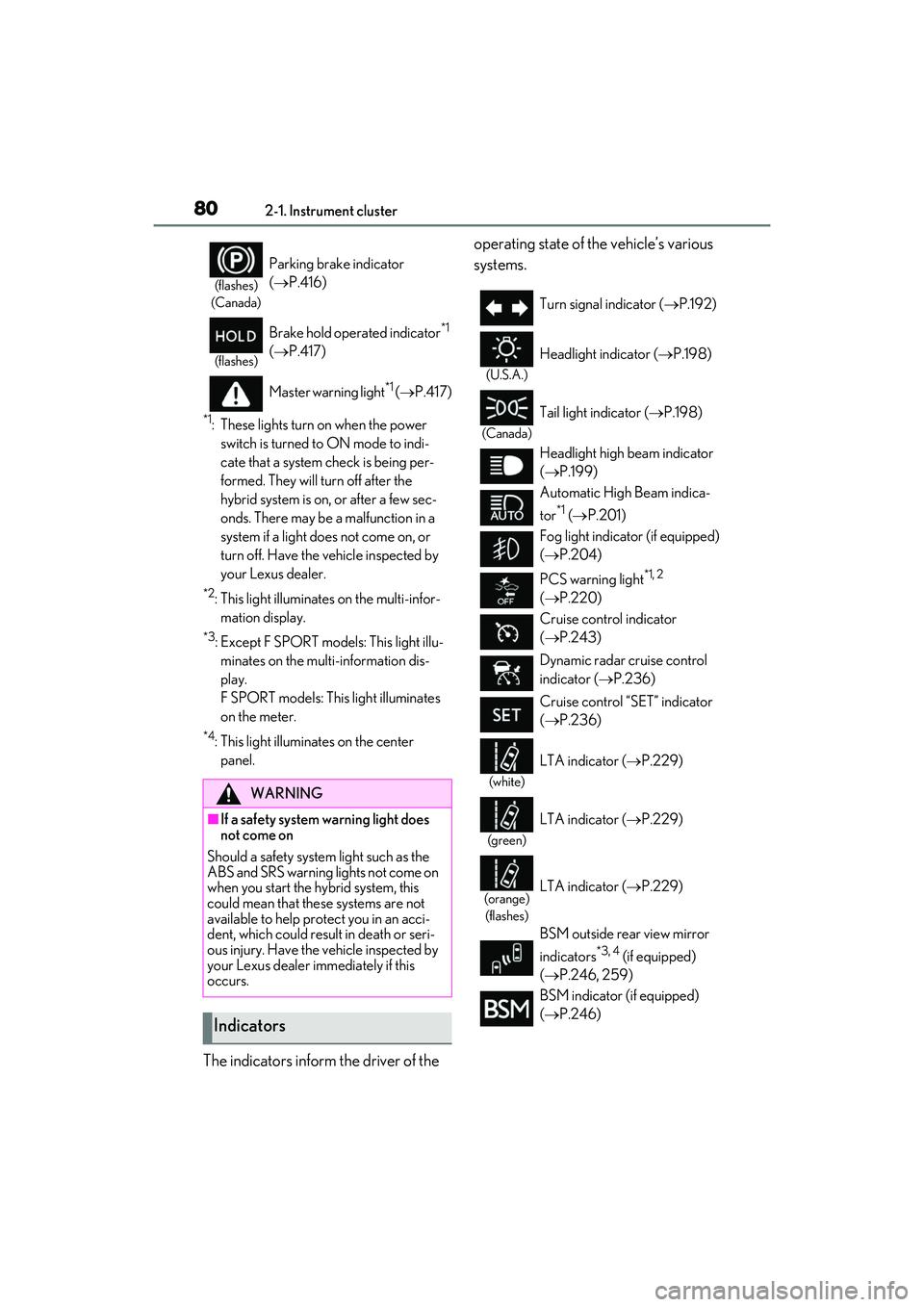
802-1. Instrument cluster
*1: These lights turn on when the power switch is turned to ON mode to indi-
cate that a system check is being per-
formed. They will turn off after the
hybrid system is on, or after a few sec-
onds. There may be a malfunction in a
system if a light does not come on, or
turn off. Have the vehicle inspected by
your Lexus dealer.
*2: This light illuminates on the multi-infor-mation display.
*3: Except F SPORT models: This light illu-minates on the multi-information dis-
play.
F SPORT models: This light illuminates
on the meter.
*4: This light illuminates on the center panel.
The indicators inform the driver of the operating state of the vehicle’s various
systems.
(flashes)
(Canada)
Parking brake indicator
( P.416)
(flashes)
Brake hold operated indicator*1
( P.417)
Master warning light
*1 ( P.417)
WARNING
■If a safety system warning light does
not come on
Should a safety system light such as the
ABS and SRS warning lights not come on
when you start the hybrid system, this
could mean that these systems are not
available to help protect you in an acci-
dent, which could result in death or seri-
ous injury. Have the vehicle inspected by
your Lexus dealer immediately if this
occurs.
Indicators
Turn signal indicator ( P.192)
(U.S.A.)
Headlight indicator (P.198)
(Canada)
Tail light indicator ( P.198)
Headlight high beam indicator
( P.199)
Automatic High Beam indica-
tor
*1 ( P.201)
Fog light indicator (if equipped)
( P.204)
PCS warning light
*1, 2
( P.220)
Cruise control indicator
( P.243)
Dynamic radar cruise control
indicator ( P.236)
Cruise control “SET” indicator
( P.236)
(white)
LTA indicator ( P.229)
(green)
LTA indicator (P.229)
(orange)
(flashes)LTA indicator ( P.229)
BSM outside rear view mirror
indicators
*3, 4 (if equipped)
( P.246, 259)
BSM indicator (if equipped)
( P.246)
Page 83 of 532
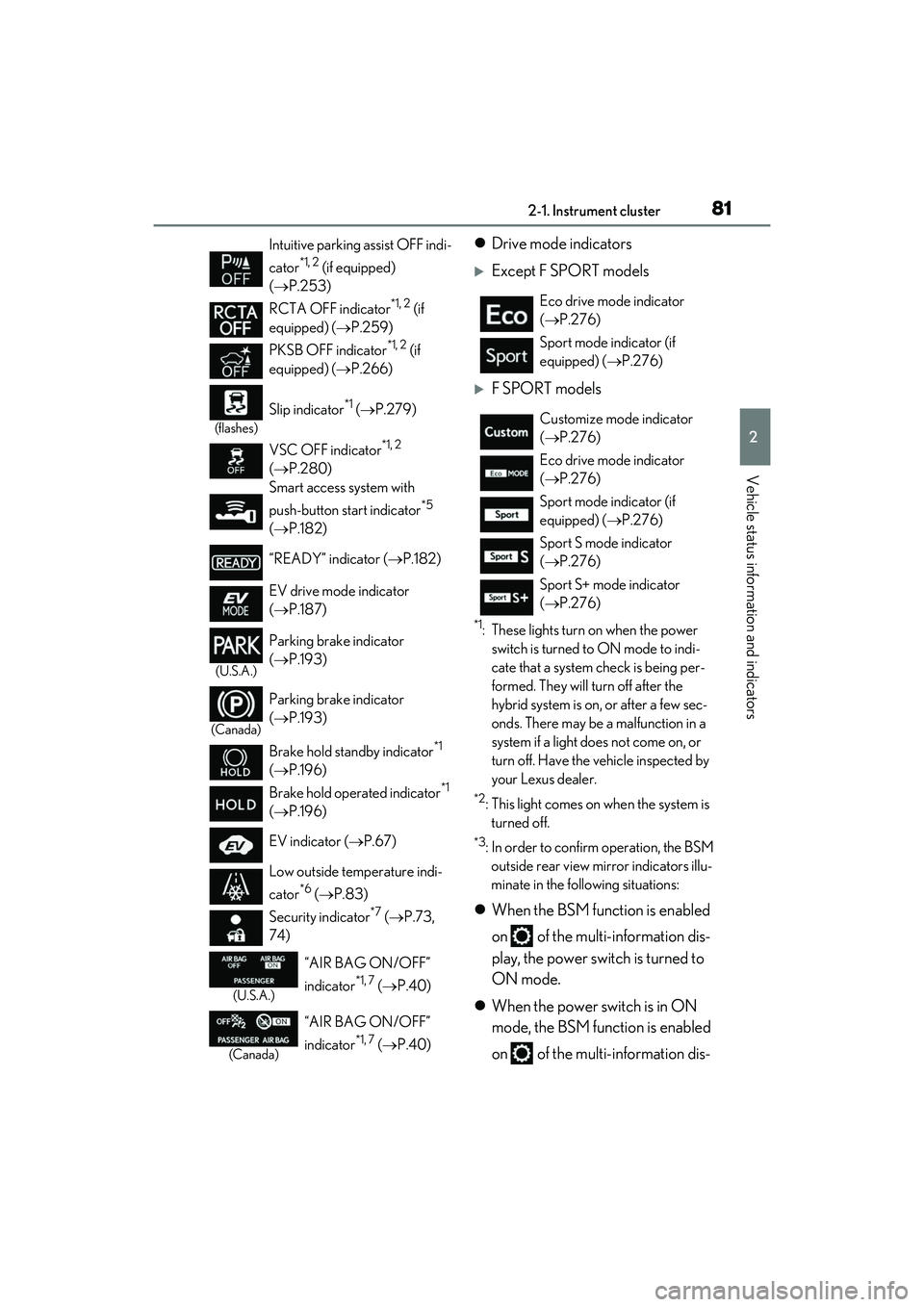
812-1. Instrument cluster
2
Vehicle status information and indicators
Drive mode indicators
Except F SPORT models
F SPORT models
*1: These lights turn on when the power
switch is turned to ON mode to indi-
cate that a system check is being per-
formed. They will turn off after the
hybrid system is on, or after a few sec-
onds. There may be a malfunction in a
system if a light does not come on, or
turn off. Have the vehicle inspected by
your Lexus dealer.
*2: This light comes on when the system is turned off.
*3: In order to confirm operation, the BSM outside rear view mirror indicators illu-
minate in the following situations:
When the BSM function is enabled
on of the multi-information dis-
play, the power switch is turned to
ON mode.
When the power switch is in ON
mode, the BSM function is enabled
on of the multi-information dis-
Intuitive parking assist OFF indi-
cator
*1, 2 (if equipped)
( P.253)
RCTA OFF indicator
*1, 2 (if
equipped) ( P.259)
PKSB OFF indicator
*1, 2 (if
equipped) ( P.266)
(flashes)
Slip indicator*1 (P.279)
VSC OFF indicator
*1, 2
( P.280)
Smart access system with
push-button start indicator
*5
( P.182)
“READY” indicator (P.182)
EV drive mode indicator
( P.187)
(U.S.A.)
Parking brake indicator
(P.193)
(Canada)
Parking brake indicator
(P.193)
Brake hold standby indicator
*1
( P.196)
Brake hold operated indicator
*1
( P.196)
EV indicator (P.67)
Low outside temperature indi-
cator
*6 ( P.83)
Security indicator
*7 ( P.73,
74)
(U.S.A.)
“AIR BAG ON/OFF”
indicator
*1, 7 ( P.40)
(Canada)
“AIR BAG ON/OFF”
indicator
*1, 7 ( P.40)
Eco drive mode indicator
(P.276)
Sport mode indicator (if
equipped) ( P.276)
Customize mode indicator
( P.276)
Eco drive mode indicator
( P.276)
Sport mode indicator (if
equipped) ( P.276)
Sport S mode indicator
( P.276)
Sport S+ mode indicator
( P.276)
Page 93 of 532
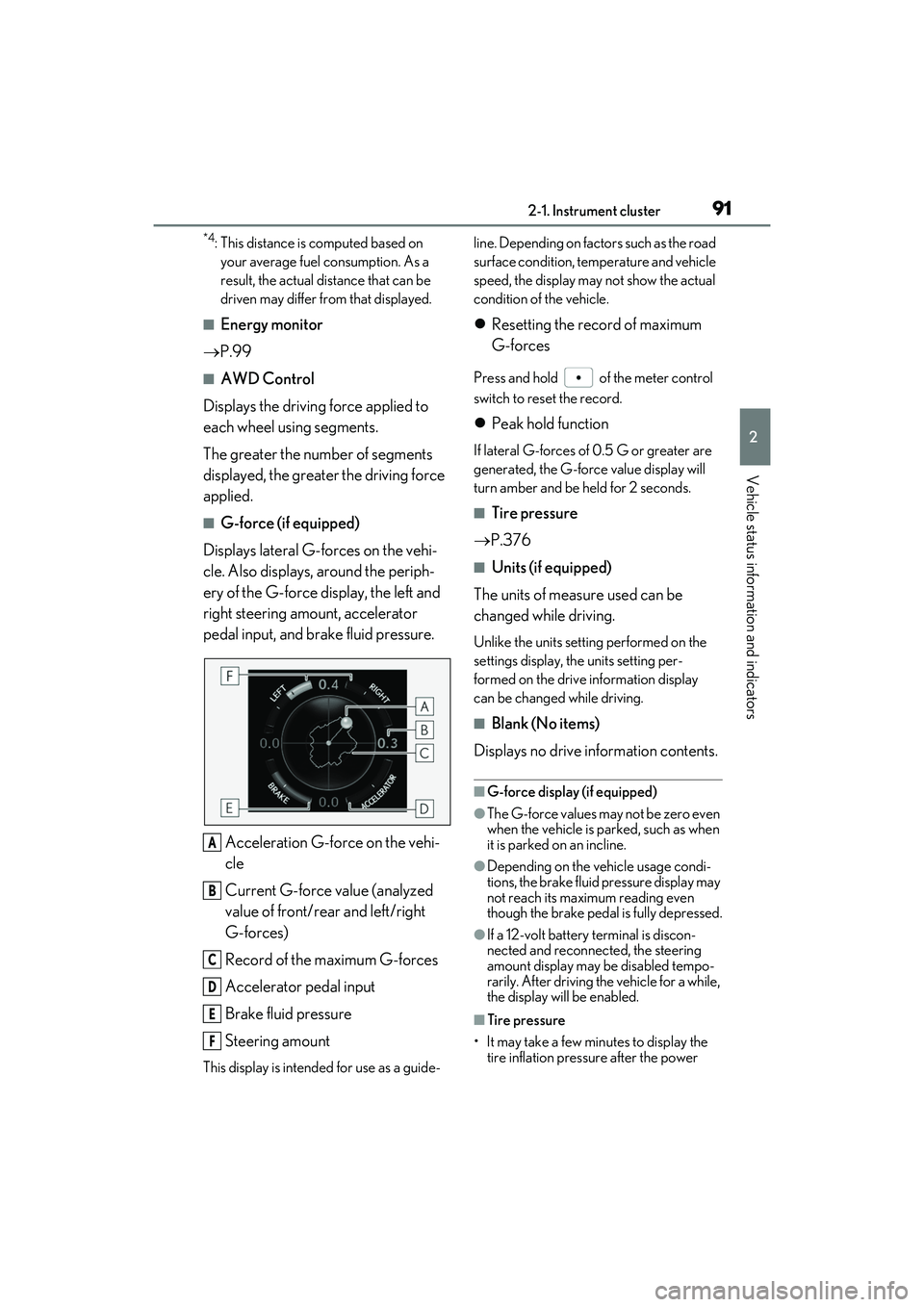
912-1. Instrument cluster
2
Vehicle status information and indicators
*4: This distance is computed based on your average fuel consumption. As a
result, the actual distance that can be
driven may differ from that displayed.
■Energy monitor
P.99
■AWD Control
Displays the driving force applied to
each wheel using segments.
The greater the number of segments
displayed, the greater the driving force
applied.
■G-force (if equipped)
Displays lateral G-forces on the vehi-
cle. Also displays, around the periph-
ery of the G-force display, the left and
right steering amount, accelerator
pedal input, and brake fluid pressure.
Acceleration G-force on the vehi-
cle
Current G-force value (analyzed
value of front/rear and left/right
G-forces)
Record of the maximum G-forces
Accelerator pedal input
Brake fluid pressure
Steering amount
This display is intended for use as a guide- line. Depending on fact
ors such as the road
surface condition, temperature and vehicle
speed, the display may not show the actual
condition of the vehicle.
Resetting the record of maximum
G-forces
Press and hold of the meter control
switch to reset the record.
Peak hold function
If lateral G-forces of 0.5 G or greater are
generated, the G-forc e value display will
turn amber and be held for 2 seconds.
■Tire pressure
P.376
■Units (if equipped)
The units of measure used can be
changed while driving.
Unlike the units setting performed on the
settings display, th e units setting per-
formed on the drive information display
can be changed while driving.
■Blank (No items)
Displays no drive information contents.
■G-force display (if equipped)
●The G-force values may not be zero even
when the vehicle is parked, such as when
it is parked on an incline.
●Depending on the vehicle usage condi-
tions, the brake fluid pressure display may
not reach its maximum reading even
though the brake pedal is fully depressed.
●If a 12-volt battery terminal is discon-
nected and reconnect ed, the steering
amount display may be disabled tempo-
rarily. After driving th e vehicle for a while,
the display will be enabled.
■Tire pressure
• It may take a few minutes to display the tire inflation pressu re after the power
A
B
C
D
E
F
Page 97 of 532
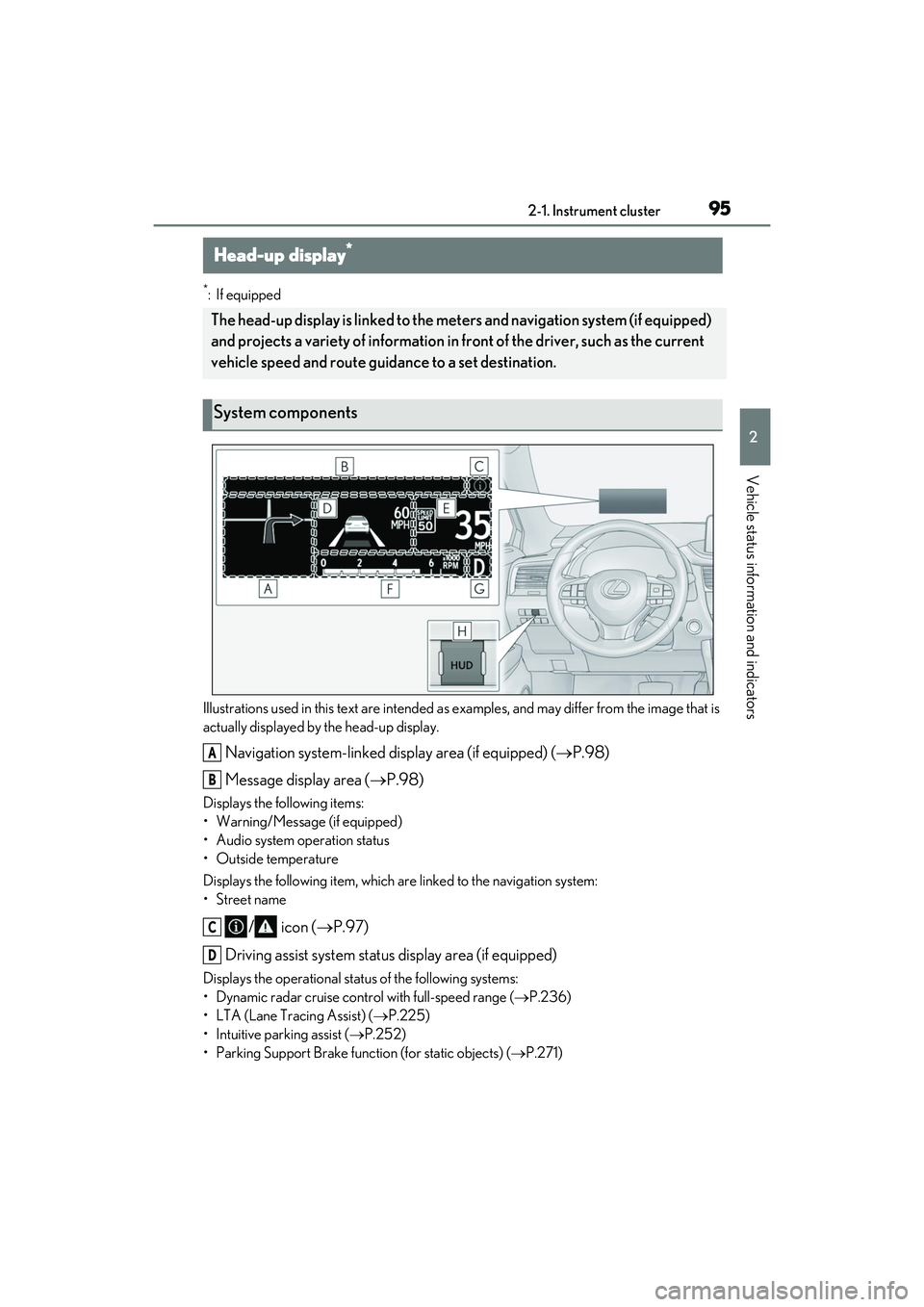
952-1. Instrument cluster
2
Vehicle status information and indicators
*:If equipped
Illustrations used in this text are intended as examples, and may differ from the image that is
actually displayed by the head-up display.
Navigation system-linked display area (if equipped) ( P.98)
Message display area ( P.98)
Displays the following items:
• Warning/Message (if equipped)
• Audio system operation status
• Outside temperature
Displays the following item, which ar e linked to the navigation system:
•Street name
/ icon ( P.97)
Driving assist system status display area (if equipped)
Displays the operational stat us of the following systems:
• Dynamic radar cruise cont rol with full-speed range (P.236)
• LTA (Lane Tracing Assist) ( P.225)
• Intuitive parking assist ( P.252)
• Parking Support Brake functi on (for static objects) (P.271)
Head-up display*
The head-up display is linked to the mete rs and navigation system (if equipped)
and projects a variety of information in front of the driver, such as the current
vehicle speed and route guidance to a set destination.
System components
A
B
C
D
Page 100 of 532
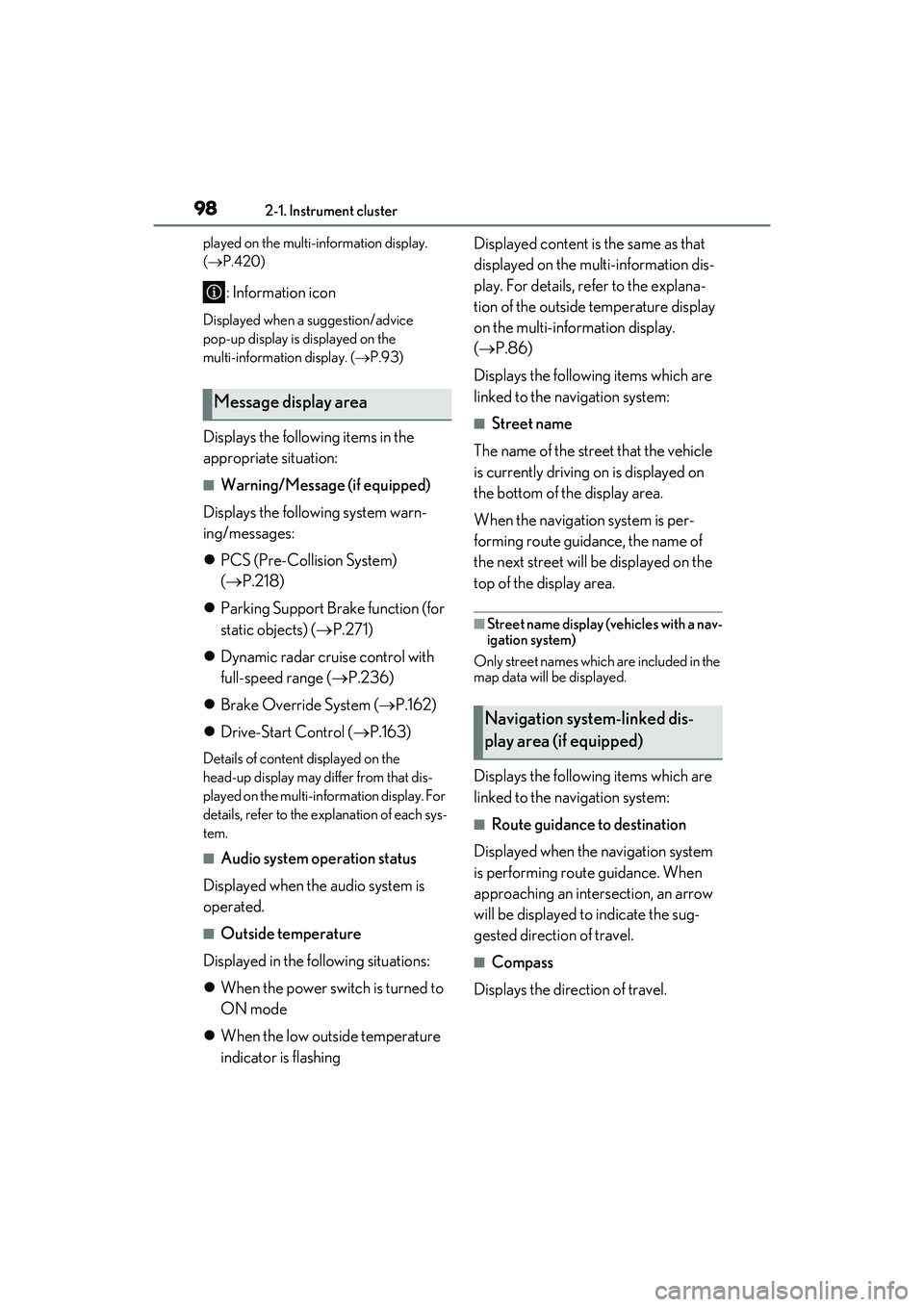
982-1. Instrument cluster
played on the multi-information display.
( P.420)
: Information icon
Displayed when a suggestion/advice
pop-up display is displayed on the
multi-information display. ( P.93)
Displays the following items in the
appropriate situation:
■Warning/Message (if equipped)
Displays the following system warn-
ing/messages:
PCS (Pre-Collision System)
( P.218)
Parking Support Brake function (for
static objects) ( P.271)
Dynamic radar cruise control with
full-speed range ( P.236)
Brake Override System ( P.162)
Drive-Start Control ( P.163)
Details of content displayed on the
head-up display may differ from that dis-
played on the multi-information display. For
details, refer to the explanation of each sys-
tem.
■Audio system operation status
Displayed when the audio system is
operated.
■Outside temperature
Displayed in the following situations:
When the power switch is turned to
ON mode
When the low outside temperature
indicator is flashing Displayed content is the same as that
displayed on the multi-information dis-
play. For details, refer to the explana-
tion of the outside temperature display
on the multi-information display.
(
P.86)
Displays the following items which are
linked to the navigation system:
■Street name
The name of the street that the vehicle
is currently driving on is displayed on
the bottom of the display area.
When the navigation system is per-
forming route guidance, the name of
the next street will be displayed on the
top of the display area.
■Street name display (vehicles with a nav-
igation system)
Only street names which are included in the
map data will be displayed.
Displays the following items which are
linked to the navigation system:
■Route guidance to destination
Displayed when the navigation system
is performing route guidance. When
approaching an intersection, an arrow
will be displayed to indicate the sug-
gested direction of travel.
■Compass
Displays the dire ction of travel.
Message display area
Navigation system-linked dis-
play area (if equipped)
Page 119 of 532

1173-2. Opening, closing and locking the doors
3
Before driving
for the operation to occur.
Kick sensor
Hands Free Power Back Door
operation detection area
3 When the kick sensor detects that
your foot is pulled back, a buzzer
will sound and the power back door
will automatically fully open/close.
If kick operation is performed again in the
middle of back door operating, the opera-
tion will stop.
■Hands free close & lock function*
(vehicles with Hands Free Power
Back Door)
*: This setting can be customized by your
Lexus dealer.
If the power back door is closed using a
Hands Free Power Back Door close
operation, all of the doors will be
locked at the same time.
A different buzzer than the normal one will
sound before the power back door begins
to close. The door lock operation signals
will operate to indicate that the power back
door has closed and al l of the doors have
locked simultaneously.
If a Hands Free Power Back Door opera-
tion is performed while the power back
door is operating, the power back door will
stop.
If a Hands Free Power Back Door opera- tion is performed again, the power back
door will open.
■Luggage compartment lights
●The luggage compartment lights turn on
when the back door is opened.
●When the power switch is turned off, the
lights will go off automatically after 20
minutes.
■Power back door operating conditions
If the following conditions are met with the
power back door oper ation enabled, the
power back door can be opened and
closed automatically.
●When an electronic key is being carried
and the back door opener switch is
pressed
*
●When the wireless remote control is
used*
●When the power switch is in ON mode,
the vehicle speed must be lower than 2
mph (3 km/h) and one of the following
conditions must be me t in addition to the
above conditions:
• The parking brake is engaged.
• The brake pedal is depressed.
• The shift lever is in P.
*: When the operation of the power back
door when it is locked has been disabled
by a customized setting, operate the
power back door after it has been
unlocked.
■Close & lock function operating condi-
tions
This function can be operated when all of
the following conditions are met:
• An electronic key is not detected within the vehicle.
• All of the doors other than the power back door are closed.
• The power switch is off.
■Hands Free Power Back Door operating
conditions (if equipped)
●The Hands Free Power Back Door (kick
sensor) setting is on.
A
B
Page 132 of 532
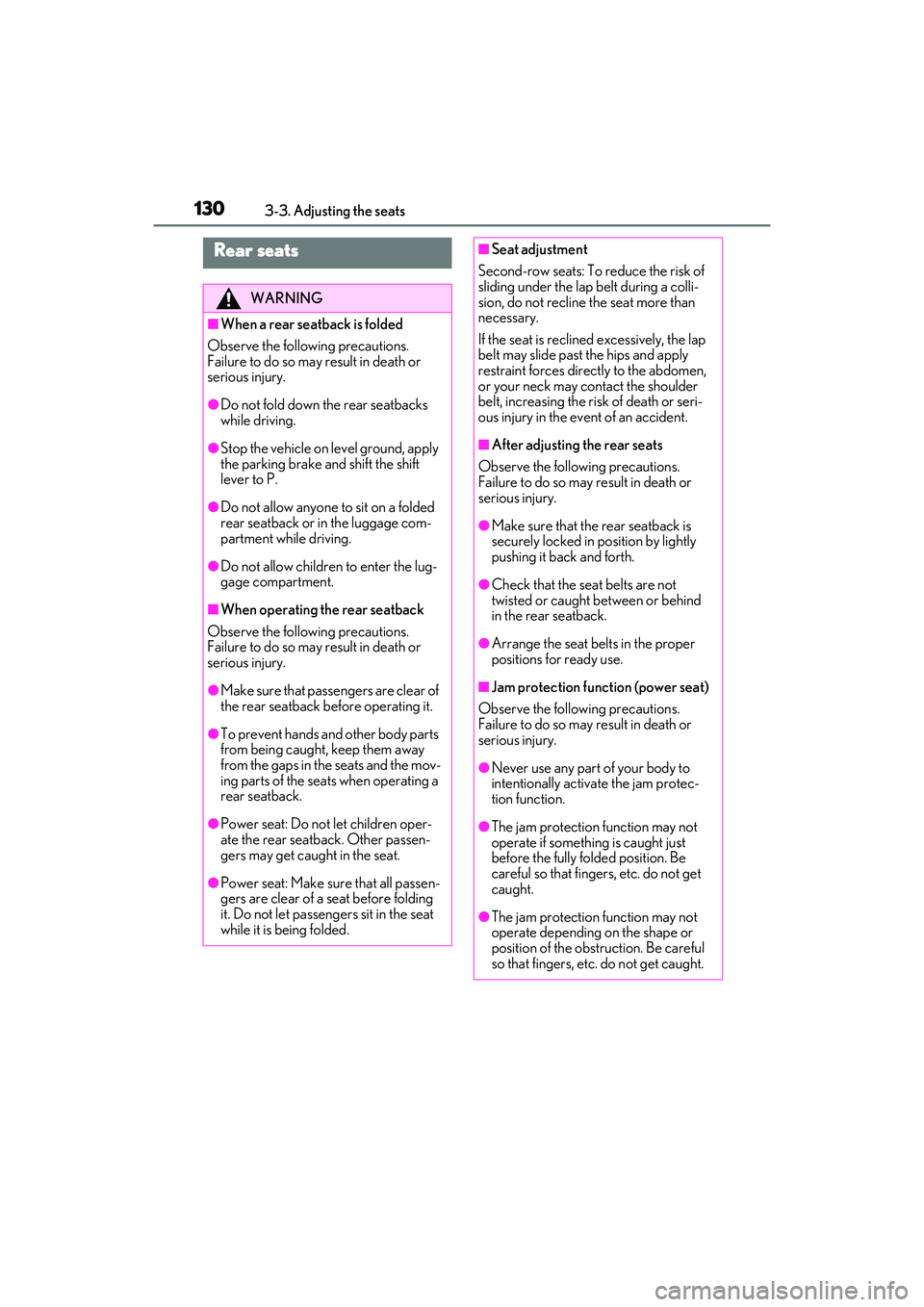
1303-3. Adjusting the seats
Rear seats
WARNING
■When a rear seatback is folded
Observe the following precautions.
Failure to do so may result in death or
serious injury.
●Do not fold down the rear seatbacks
while driving.
●Stop the vehicle on level ground, apply
the parking brake and shift the shift
lever to P.
●Do not allow anyone to sit on a folded
rear seatback or in the luggage com-
partment while driving.
●Do not allow children to enter the lug-
gage compartment.
■When operating the rear seatback
Observe the following precautions.
Failure to do so may result in death or
serious injury.
●Make sure that passengers are clear of
the rear seatback before operating it.
●To prevent hands and other body parts
from being caught, keep them away
from the gaps in the seats and the mov-
ing parts of the seat s when operating a
rear seatback.
●Power seat: Do not let children oper-
ate the rear seatback. Other passen-
gers may get caught in the seat.
●Power seat: Make su re that all passen-
gers are clear of a seat before folding
it. Do not let passeng ers sit in the seat
while it is being folded.
■Seat adjustment
Second-row seats: To reduce the risk of
sliding under the lap belt during a colli-
sion, do not recline the seat more than
necessary.
If the seat is reclin ed excessively, the lap
belt may slide past the hips and apply
restraint forces direct ly to the abdomen,
or your neck may contact the shoulder
belt, increasing the risk of death or seri-
ous injury in the event of an accident.
■After adjusting the rear seats
Observe the following precautions.
Failure to do so may result in death or
serious injury.
●Make sure that the rear seatback is
securely locked in position by lightly
pushing it back and forth.
●Check that the seat belts are not
twisted or caught between or behind
in the rear seatback.
●Arrange the seat belts in the proper
positions for ready use.
■Jam protection function (power seat)
Observe the following precautions.
Failure to do so may result in death or
serious injury.
●Never use any part of your body to
intentionally activate the jam protec-
tion function.
●The jam protection function may not
operate if somethin g is caught just
before the fully folded position. Be
careful so that finger s, etc. do not get
caught.
●The jam protection function may not
operate depending on the shape or
position of the obstruction. Be careful
so that fingers, etc. do not get caught.
Page 138 of 532
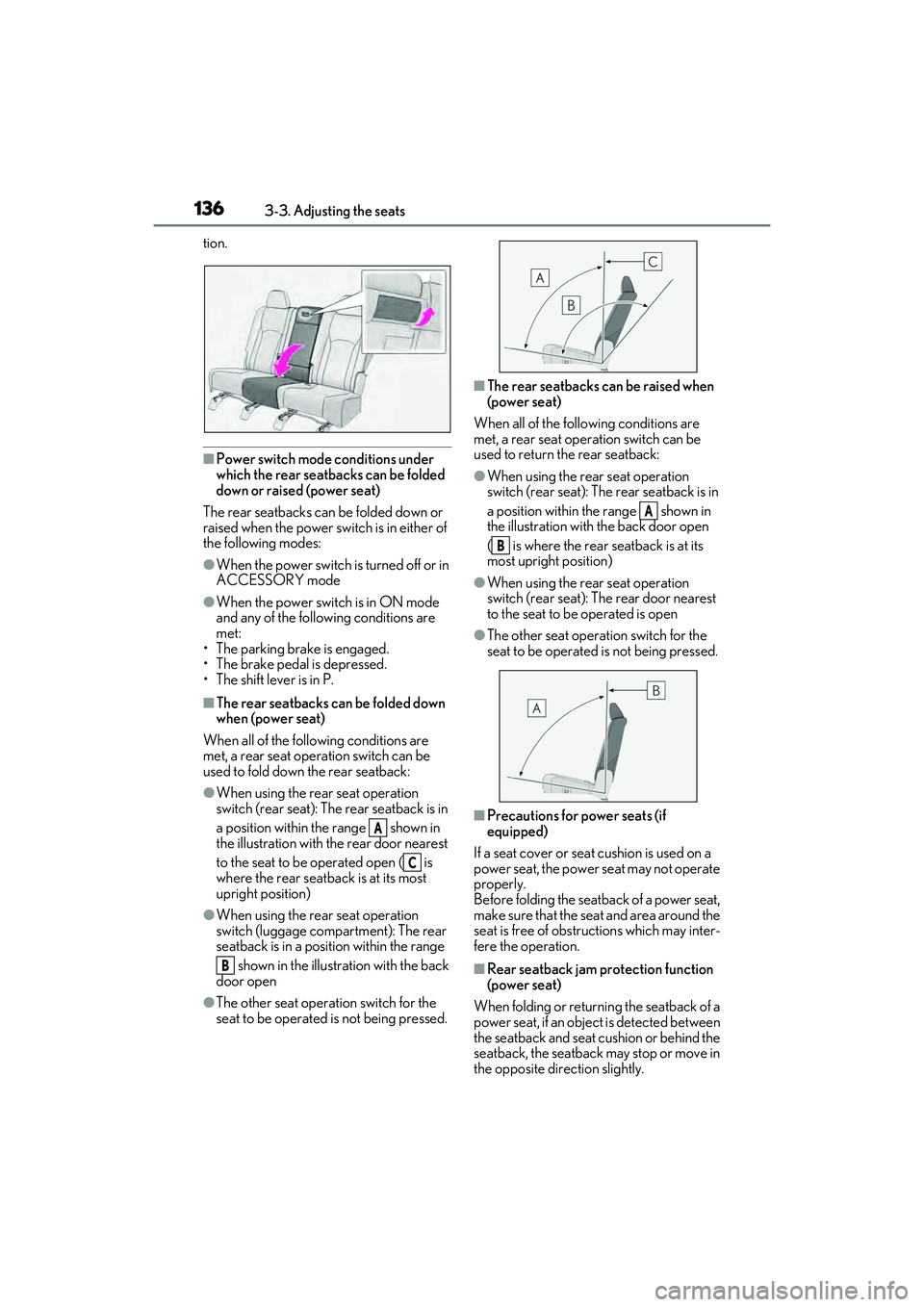
1363-3. Adjusting the seats
tion.
■Power switch mode conditions under
which the rear seatbacks can be folded
down or raised (power seat)
The rear seatbacks can be folded down or
raised when the power switch is in either of
the following modes:
●When the power switch is turned off or in
ACCESSORY mode
●When the power switch is in ON mode
and any of the following conditions are
met:
• The parking brake is engaged.
• The brake pedal is depressed.
• The shift lever is in P.
■The rear seatbacks can be folded down
when (power seat)
When all of the following conditions are
met, a rear seat operation switch can be
used to fold down the rear seatback:
●When using the rear seat operation
switch (rear seat): The rear seatback is in
a position within the range shown in
the illustration with the rear door nearest
to the seat to be operated open ( is
where the rear seatback is at its most
upright position)
●When using the rear seat operation
switch (luggage compartment): The rear
seatback is in a position within the range
shown in the illustration with the back
door open
●The other seat operation switch for the
seat to be operated is not being pressed.
■The rear seatbacks can be raised when
(power seat)
When all of the following conditions are
met, a rear seat operation switch can be
used to return the rear seatback:
●When using the rear seat operation
switch (rear seat): The rear seatback is in
a position within the range shown in
the illustration with the back door open
( is where the rear seatback is at its
most upright position)
●When using the rear seat operation
switch (rear seat): Th e rear door nearest
to the seat to be operated is open
●The other seat operat ion switch for the
seat to be operated is not being pressed.
■Precautions for power seats (if
equipped)
If a seat cover or seat cushion is used on a
power seat, the power seat may not operate
properly.
Before folding the seatback of a power seat,
make sure that the seat and area around the
seat is free of obstructions which may inter-
fere the operation.
■Rear seatback jam protection function
(power seat)
When folding or return ing the seatback of a
power seat, if an object is detected between
the seatback and seat cushion or behind the
seatback, the seatback may stop or move in
the opposite direction slightly.
A
C
B
A
B
Page 163 of 532
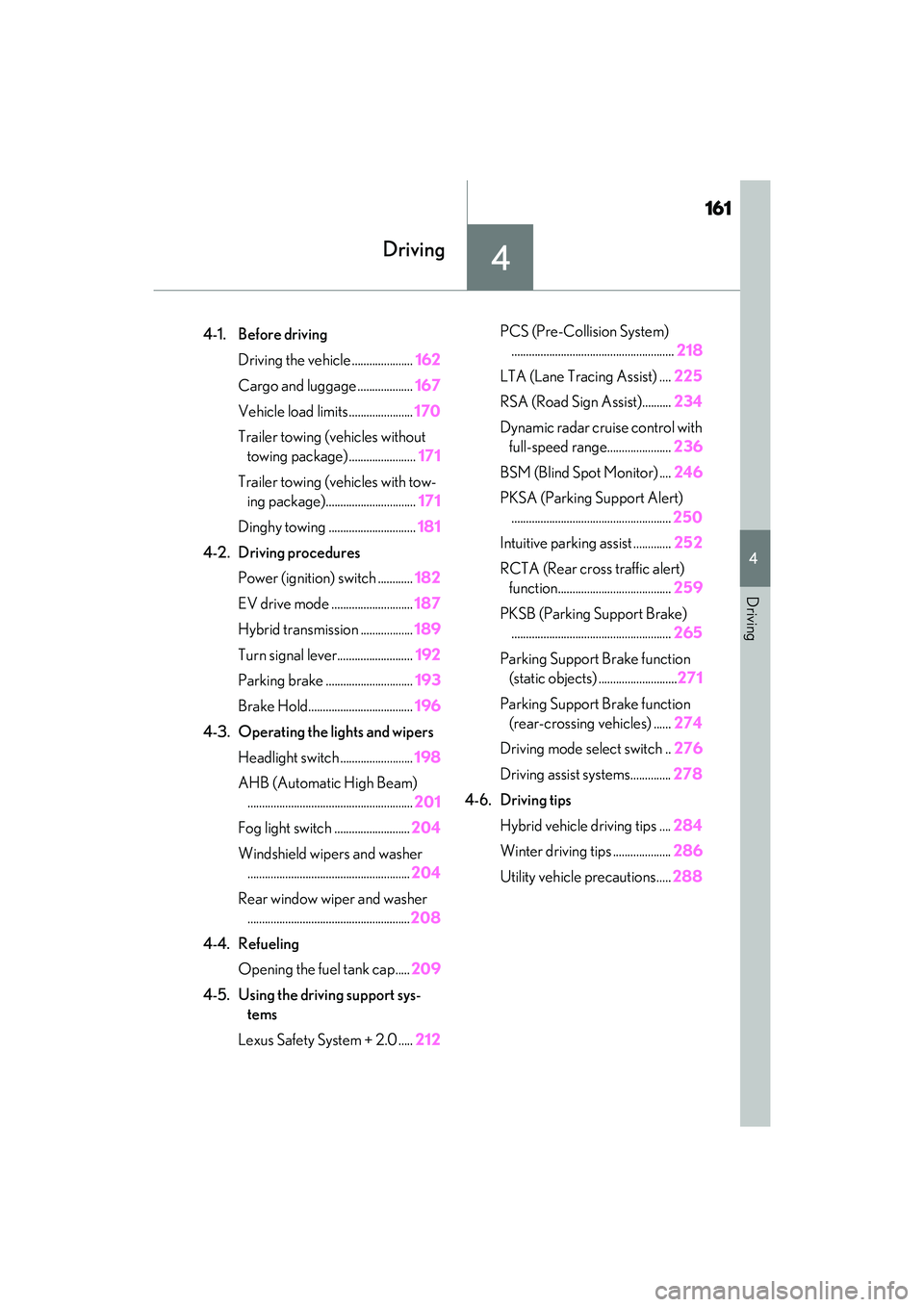
161
4
4
Driving
Driving
.4-1. Before drivingDriving the vehicle ..................... 162
Cargo and luggage ................... 167
Vehicle load limits ...................... 170
Trailer towing (vehicles without towing package) ....................... 171
Trailer towing (vehicles with tow- ing package)............................... 171
Dinghy towing .............................. 181
4-2. Driving procedures Power (ignition) switch ............ 182
EV drive mode ............................ 187
Hybrid transmission .................. 189
Turn signal lever.......................... 192
Parking brake .............................. 193
Brake Hold.................................... 196
4-3. Operating the lights and wipers Headlight switch ......................... 198
AHB (Automatic High Beam) ......................................................... 201
Fog light switch .......................... 204
Windshield wipers and washer ........................................................ 204
Rear window wiper and washer ........................................................ 208
4-4. Refueling Opening the fuel tank cap..... 209
4-5. Using the driving support sys- tems
Lexus Safety System + 2.0 ..... 212PCS (Pre-Collision System)
........................................................ 218
LTA (Lane Tracing Assist) .... 225
RSA (Road Sign Assist).......... 234
Dynamic radar cruise control with full-speed range...................... 236
BSM (Blind Spot Monitor) .... 246
PKSA (Parking Support Alert) ....................................................... 250
Intuitive parking assist ............. 252
RCTA (Rear cross traffic alert) function....................................... 259
PKSB (Parking Support Brake) ....................................................... 265
Parking Support Brake function (static objects) ........................... 271
Parking Support Brake function (rear-crossing vehicles) ...... 274
Driving mode select switch .. 276
Driving assist systems.............. 278
4-6. Driving tips Hybrid vehicle driving tips .... 284
Winter driving tips .................... 286
Utility vehicle precautions..... 288
Page 164 of 532

1624-1. Before driving
4-1.Before driving
■Starting the hybrid system
P.182
■Driving
1 With the brake pedal depressed,
shift the shift lever to D. ( P.189)
2 Release the parking brake.
( P.193)
If the parking brake is in automatic mode,
the parking brake is released automatically
when shifting the shift lever to any position
other than P. ( P.194)
3Gradually release the brake pedal
and gently depress the accelerator
pedal to accelerate the vehicle.
■Stopping
1 With the shift lever in D, depress the
brake pedal.
2 If necessary, set the parking brake.
( P.193)
If the vehicle is to be stopped for an
extended period of time, shift the shift lever
to P or N. ( P.189)
■Parking the vehicle
1 With the shift lever in D, depress the
brake pedal.
2 Set the parking brake ( P.193),
and shift the shift lever to P
( P.189).
3 Press the power switch to stop the
hybrid system. 4
Lock the door, making sure that you
have the electronic key on your
person.
If parking on a hill, block the wheels as
needed.
■Starting off on a steep uphill
1 With the brake pedal depressed,
shift the shift lever to D. ( P.189)
2 Pull the parking brake switch and
parking brake is set manually.
( P.193)
3 Release the brake pedal and gently
depress the accelerator pedal to
accelerate the vehicle.
4 Press the parking brake switch and
parking brake is released manually.
■When starting off on a uphill
The hill-start assist control will activate.
( P.279)
■For fuel-efficient driving
Keep in mind that hybr id vehicles are similar
to conventional vehicles, and it is necessary
to refrain from activities such as sudden
acceleration. ( P.284)
■Driving in the rain
●Drive carefully when it is raining, because
visibility will be re duced, the windows
may become fogged-u p, and the road
will be slippery.
●Drive carefully when it starts to rain,
because the road surface will be espe-
cially slippery.
●Refrain from high speeds when driving on
an expressway in the rain, because there
may be a layer of water between the tires
and the road surface, preventing the
steering and brakes from operating prop-
erly.
■Restraining the hybrid system output
(Brake Override System)
●When the accelerato r and brake pedals
are depressed at the same time, the
Driving the vehicle
The following procedures should be
observed to ensure safe driving:
Driving procedure